EBP Nursing Research: Handwashing to Reduce HAIs in Healthcare
VerifiedAdded on 2023/06/15
|16
|3247
|486
Report
AI Summary
This report examines the critical healthcare problem of healthcare-associated infections (HAIs) and the significance of implementing effective handwashing protocols to reduce their incidence. It reviews current practices, highlighting the low compliance with handwashing and the resulting negative impact on patient outcomes and healthcare resource utilization. A PICO question is formulated to investigate the effect of regular handwashing on HAI rates. The research methodology involves a literature search, identifying both research and non-research evidence supporting the efficacy of hand hygiene. An evidence matrix summarizes key studies, including their methodologies and findings. The report recommends implementing robust handwashing protocols, emphasizing the need for policy reforms, resource allocation, and stakeholder engagement. Key barriers, such as lack of leadership and insufficient funding, are addressed with proposed strategies for improvement. The outcome of the practice change will be measured by monitoring changes in HAI rates after implementing the handwashing protocol. This document is available on Desklib, where students can find additional resources and solved assignments.
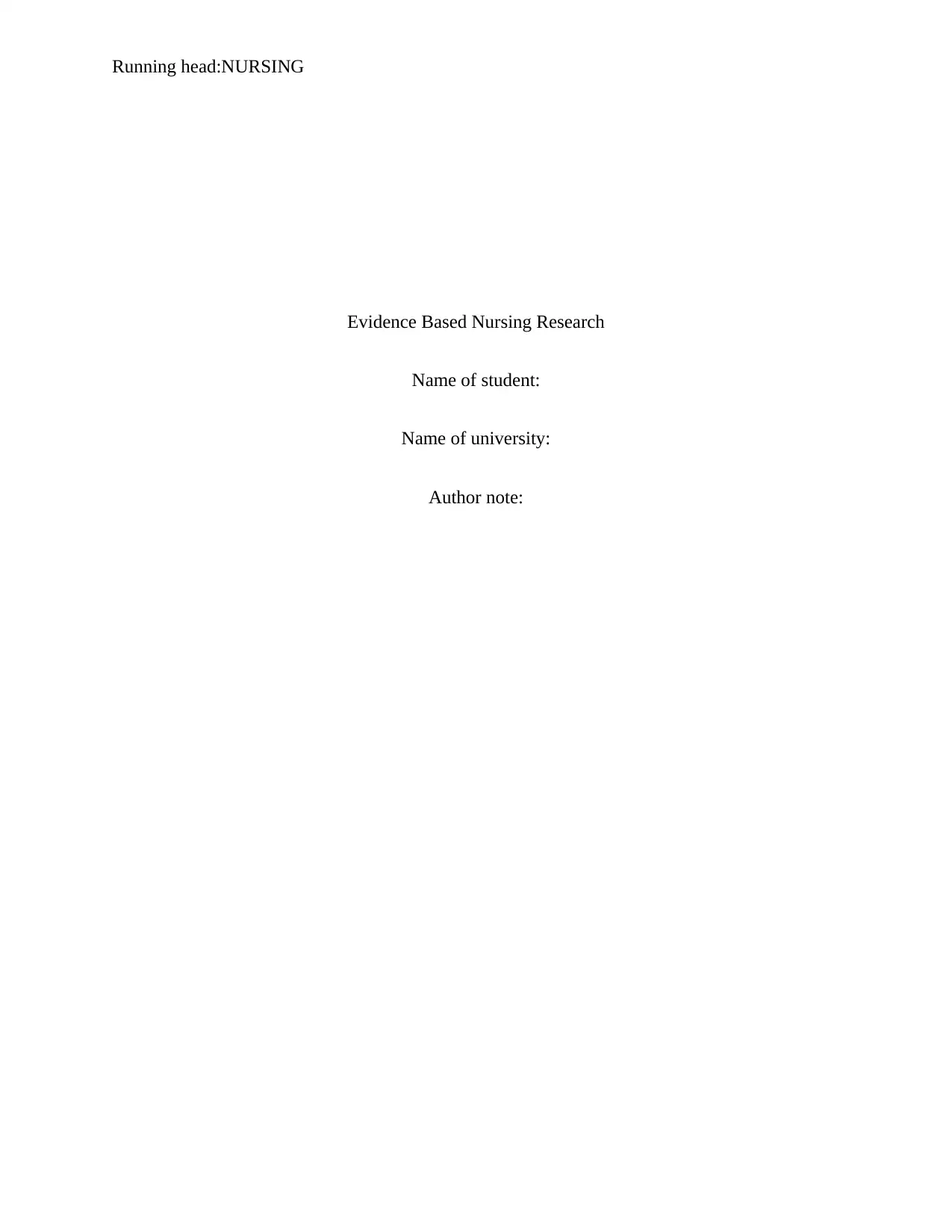
Running head:NURSING
Evidence Based Nursing Research
Name of student:
Name of university:
Author note:
Evidence Based Nursing Research
Name of student:
Name of university:
Author note:
Paraphrase This Document
Need a fresh take? Get an instant paraphrase of this document with our AI Paraphraser
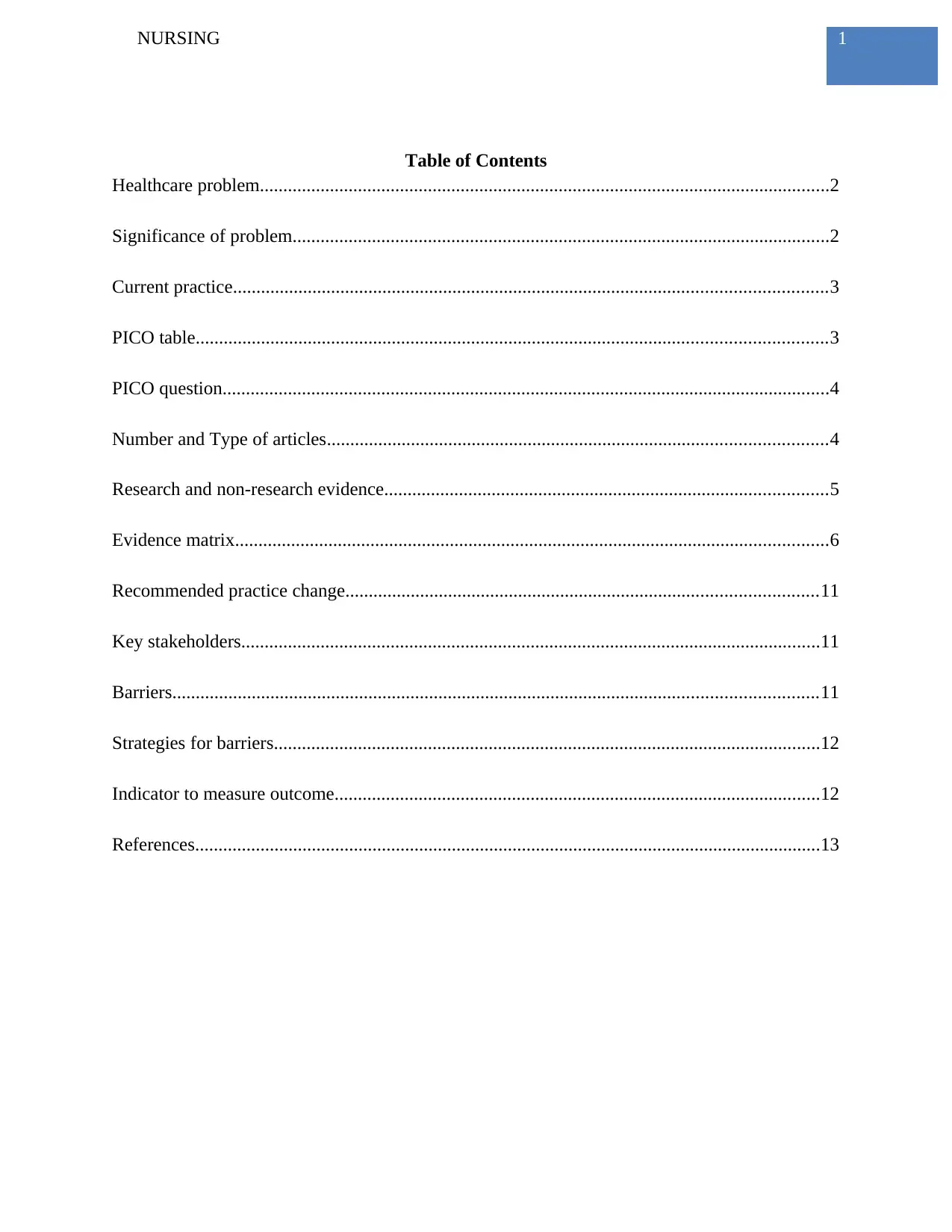
1NURSING
Table of Contents
Healthcare problem..........................................................................................................................2
Significance of problem...................................................................................................................2
Current practice...............................................................................................................................3
PICO table.......................................................................................................................................3
PICO question..................................................................................................................................4
Number and Type of articles...........................................................................................................4
Research and non-research evidence...............................................................................................5
Evidence matrix...............................................................................................................................6
Recommended practice change.....................................................................................................11
Key stakeholders............................................................................................................................11
Barriers..........................................................................................................................................11
Strategies for barriers.....................................................................................................................12
Indicator to measure outcome........................................................................................................12
References......................................................................................................................................13
Table of Contents
Healthcare problem..........................................................................................................................2
Significance of problem...................................................................................................................2
Current practice...............................................................................................................................3
PICO table.......................................................................................................................................3
PICO question..................................................................................................................................4
Number and Type of articles...........................................................................................................4
Research and non-research evidence...............................................................................................5
Evidence matrix...............................................................................................................................6
Recommended practice change.....................................................................................................11
Key stakeholders............................................................................................................................11
Barriers..........................................................................................................................................11
Strategies for barriers.....................................................................................................................12
Indicator to measure outcome........................................................................................................12
References......................................................................................................................................13
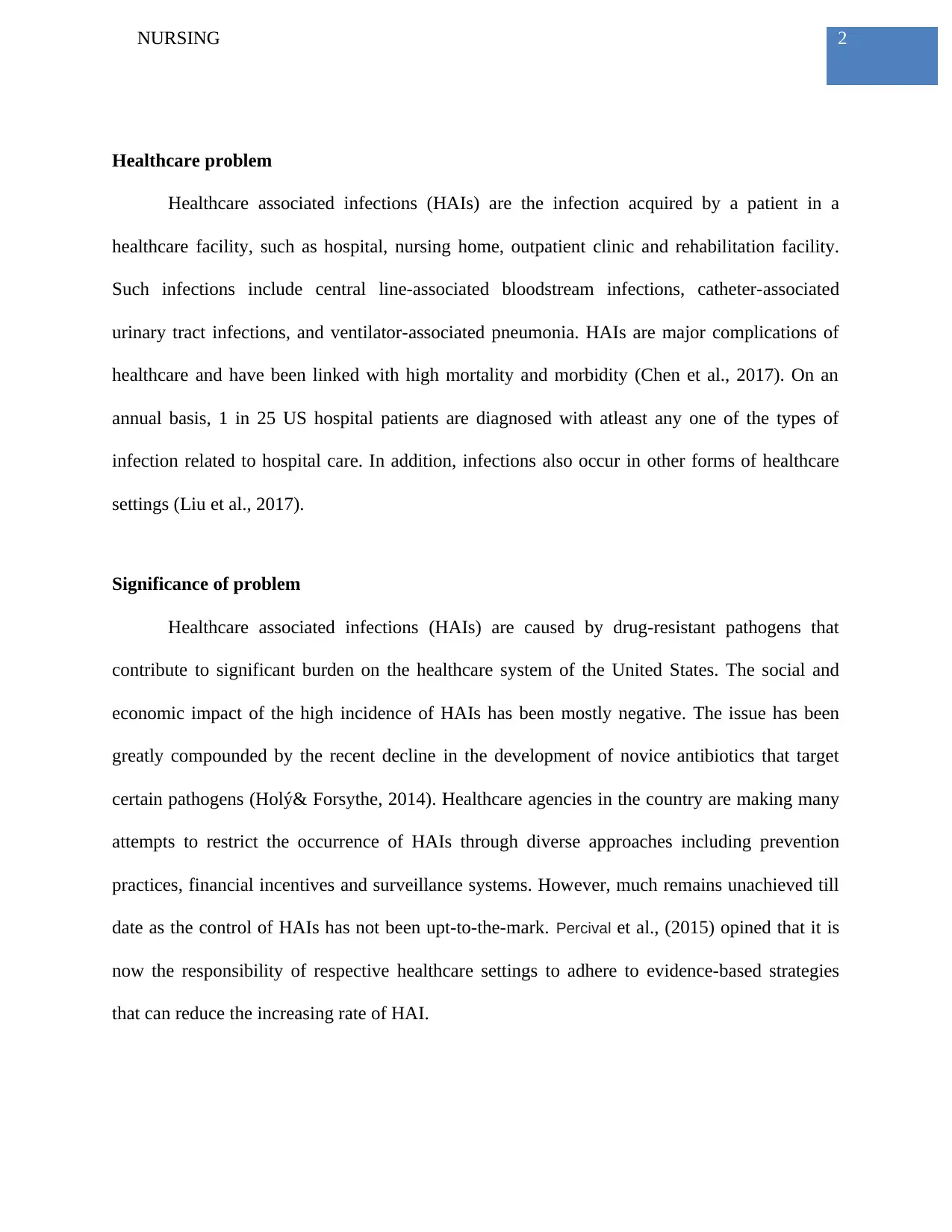
2NURSING
Healthcare problem
Healthcare associated infections (HAIs) are the infection acquired by a patient in a
healthcare facility, such as hospital, nursing home, outpatient clinic and rehabilitation facility.
Such infections include central line-associated bloodstream infections, catheter-associated
urinary tract infections, and ventilator-associated pneumonia. HAIs are major complications of
healthcare and have been linked with high mortality and morbidity (Chen et al., 2017). On an
annual basis, 1 in 25 US hospital patients are diagnosed with atleast any one of the types of
infection related to hospital care. In addition, infections also occur in other forms of healthcare
settings (Liu et al., 2017).
Significance of problem
Healthcare associated infections (HAIs) are caused by drug-resistant pathogens that
contribute to significant burden on the healthcare system of the United States. The social and
economic impact of the high incidence of HAIs has been mostly negative. The issue has been
greatly compounded by the recent decline in the development of novice antibiotics that target
certain pathogens (Holý& Forsythe, 2014). Healthcare agencies in the country are making many
attempts to restrict the occurrence of HAIs through diverse approaches including prevention
practices, financial incentives and surveillance systems. However, much remains unachieved till
date as the control of HAIs has not been upt-to-the-mark. Percival et al., (2015) opined that it is
now the responsibility of respective healthcare settings to adhere to evidence-based strategies
that can reduce the increasing rate of HAI.
Healthcare problem
Healthcare associated infections (HAIs) are the infection acquired by a patient in a
healthcare facility, such as hospital, nursing home, outpatient clinic and rehabilitation facility.
Such infections include central line-associated bloodstream infections, catheter-associated
urinary tract infections, and ventilator-associated pneumonia. HAIs are major complications of
healthcare and have been linked with high mortality and morbidity (Chen et al., 2017). On an
annual basis, 1 in 25 US hospital patients are diagnosed with atleast any one of the types of
infection related to hospital care. In addition, infections also occur in other forms of healthcare
settings (Liu et al., 2017).
Significance of problem
Healthcare associated infections (HAIs) are caused by drug-resistant pathogens that
contribute to significant burden on the healthcare system of the United States. The social and
economic impact of the high incidence of HAIs has been mostly negative. The issue has been
greatly compounded by the recent decline in the development of novice antibiotics that target
certain pathogens (Holý& Forsythe, 2014). Healthcare agencies in the country are making many
attempts to restrict the occurrence of HAIs through diverse approaches including prevention
practices, financial incentives and surveillance systems. However, much remains unachieved till
date as the control of HAIs has not been upt-to-the-mark. Percival et al., (2015) opined that it is
now the responsibility of respective healthcare settings to adhere to evidence-based strategies
that can reduce the increasing rate of HAI.
⊘ This is a preview!⊘
Do you want full access?
Subscribe today to unlock all pages.

Trusted by 1+ million students worldwide
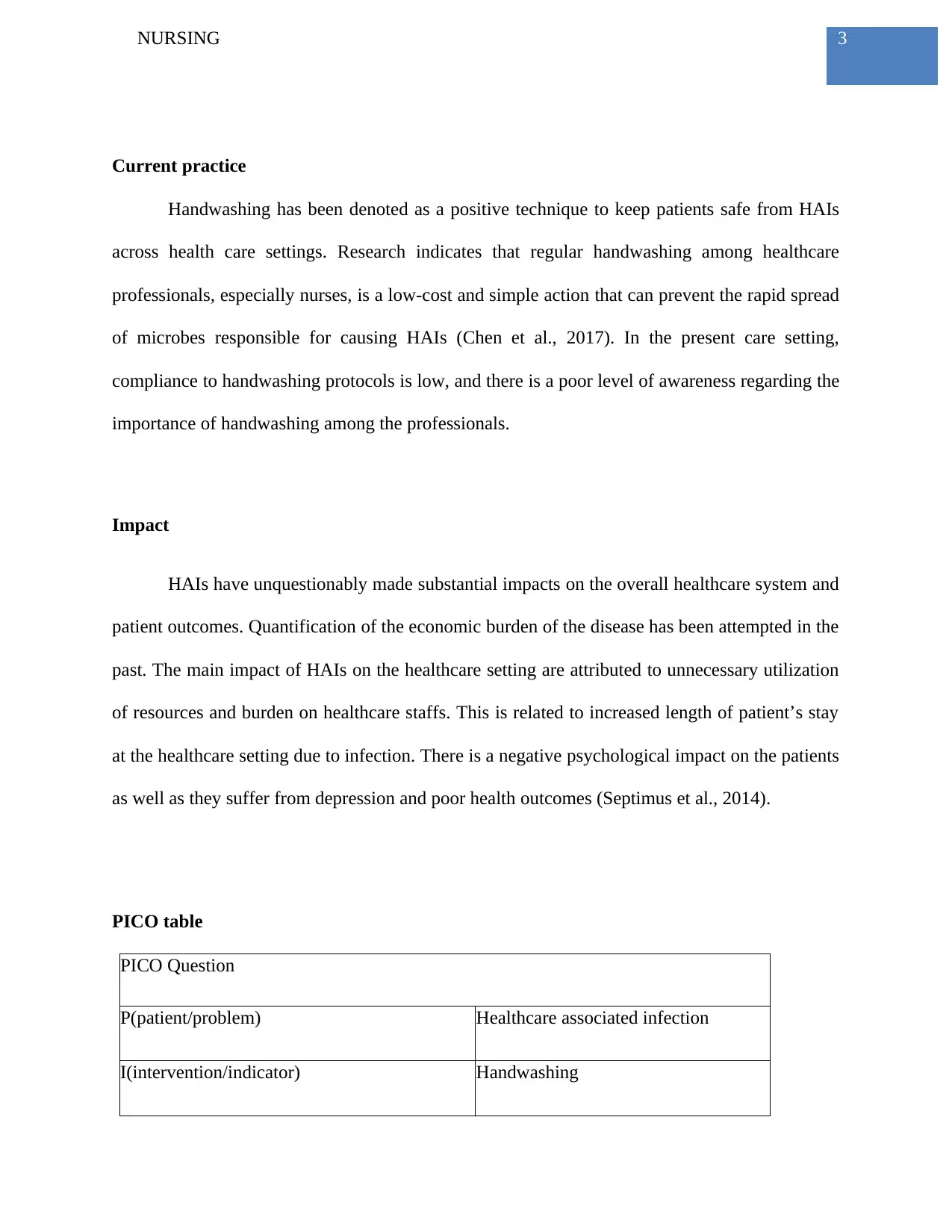
3NURSING
Current practice
Handwashing has been denoted as a positive technique to keep patients safe from HAIs
across health care settings. Research indicates that regular handwashing among healthcare
professionals, especially nurses, is a low-cost and simple action that can prevent the rapid spread
of microbes responsible for causing HAIs (Chen et al., 2017). In the present care setting,
compliance to handwashing protocols is low, and there is a poor level of awareness regarding the
importance of handwashing among the professionals.
Impact
HAIs have unquestionably made substantial impacts on the overall healthcare system and
patient outcomes. Quantification of the economic burden of the disease has been attempted in the
past. The main impact of HAIs on the healthcare setting are attributed to unnecessary utilization
of resources and burden on healthcare staffs. This is related to increased length of patient’s stay
at the healthcare setting due to infection. There is a negative psychological impact on the patients
as well as they suffer from depression and poor health outcomes (Septimus et al., 2014).
PICO table
PICO Question
P(patient/problem) Healthcare associated infection
I(intervention/indicator) Handwashing
Current practice
Handwashing has been denoted as a positive technique to keep patients safe from HAIs
across health care settings. Research indicates that regular handwashing among healthcare
professionals, especially nurses, is a low-cost and simple action that can prevent the rapid spread
of microbes responsible for causing HAIs (Chen et al., 2017). In the present care setting,
compliance to handwashing protocols is low, and there is a poor level of awareness regarding the
importance of handwashing among the professionals.
Impact
HAIs have unquestionably made substantial impacts on the overall healthcare system and
patient outcomes. Quantification of the economic burden of the disease has been attempted in the
past. The main impact of HAIs on the healthcare setting are attributed to unnecessary utilization
of resources and burden on healthcare staffs. This is related to increased length of patient’s stay
at the healthcare setting due to infection. There is a negative psychological impact on the patients
as well as they suffer from depression and poor health outcomes (Septimus et al., 2014).
PICO table
PICO Question
P(patient/problem) Healthcare associated infection
I(intervention/indicator) Handwashing
Paraphrase This Document
Need a fresh take? Get an instant paraphrase of this document with our AI Paraphraser
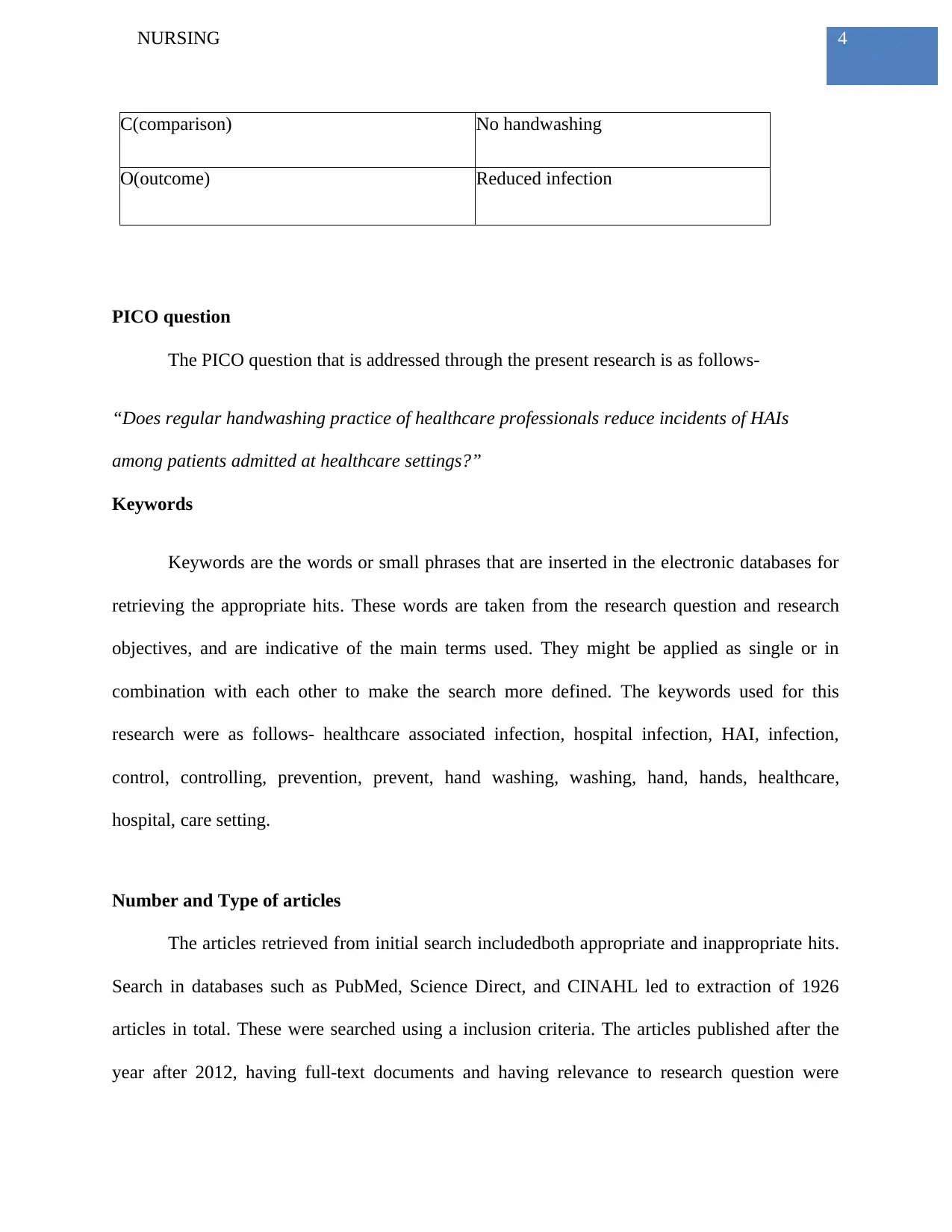
4NURSING
C(comparison) No handwashing
O(outcome) Reduced infection
PICO question
The PICO question that is addressed through the present research is as follows-
“Does regular handwashing practice of healthcare professionals reduce incidents of HAIs
among patients admitted at healthcare settings?”
Keywords
Keywords are the words or small phrases that are inserted in the electronic databases for
retrieving the appropriate hits. These words are taken from the research question and research
objectives, and are indicative of the main terms used. They might be applied as single or in
combination with each other to make the search more defined. The keywords used for this
research were as follows- healthcare associated infection, hospital infection, HAI, infection,
control, controlling, prevention, prevent, hand washing, washing, hand, hands, healthcare,
hospital, care setting.
Number and Type of articles
The articles retrieved from initial search includedboth appropriate and inappropriate hits.
Search in databases such as PubMed, Science Direct, and CINAHL led to extraction of 1926
articles in total. These were searched using a inclusion criteria. The articles published after the
year after 2012, having full-text documents and having relevance to research question were
C(comparison) No handwashing
O(outcome) Reduced infection
PICO question
The PICO question that is addressed through the present research is as follows-
“Does regular handwashing practice of healthcare professionals reduce incidents of HAIs
among patients admitted at healthcare settings?”
Keywords
Keywords are the words or small phrases that are inserted in the electronic databases for
retrieving the appropriate hits. These words are taken from the research question and research
objectives, and are indicative of the main terms used. They might be applied as single or in
combination with each other to make the search more defined. The keywords used for this
research were as follows- healthcare associated infection, hospital infection, HAI, infection,
control, controlling, prevention, prevent, hand washing, washing, hand, hands, healthcare,
hospital, care setting.
Number and Type of articles
The articles retrieved from initial search includedboth appropriate and inappropriate hits.
Search in databases such as PubMed, Science Direct, and CINAHL led to extraction of 1926
articles in total. These were searched using a inclusion criteria. The articles published after the
year after 2012, having full-text documents and having relevance to research question were
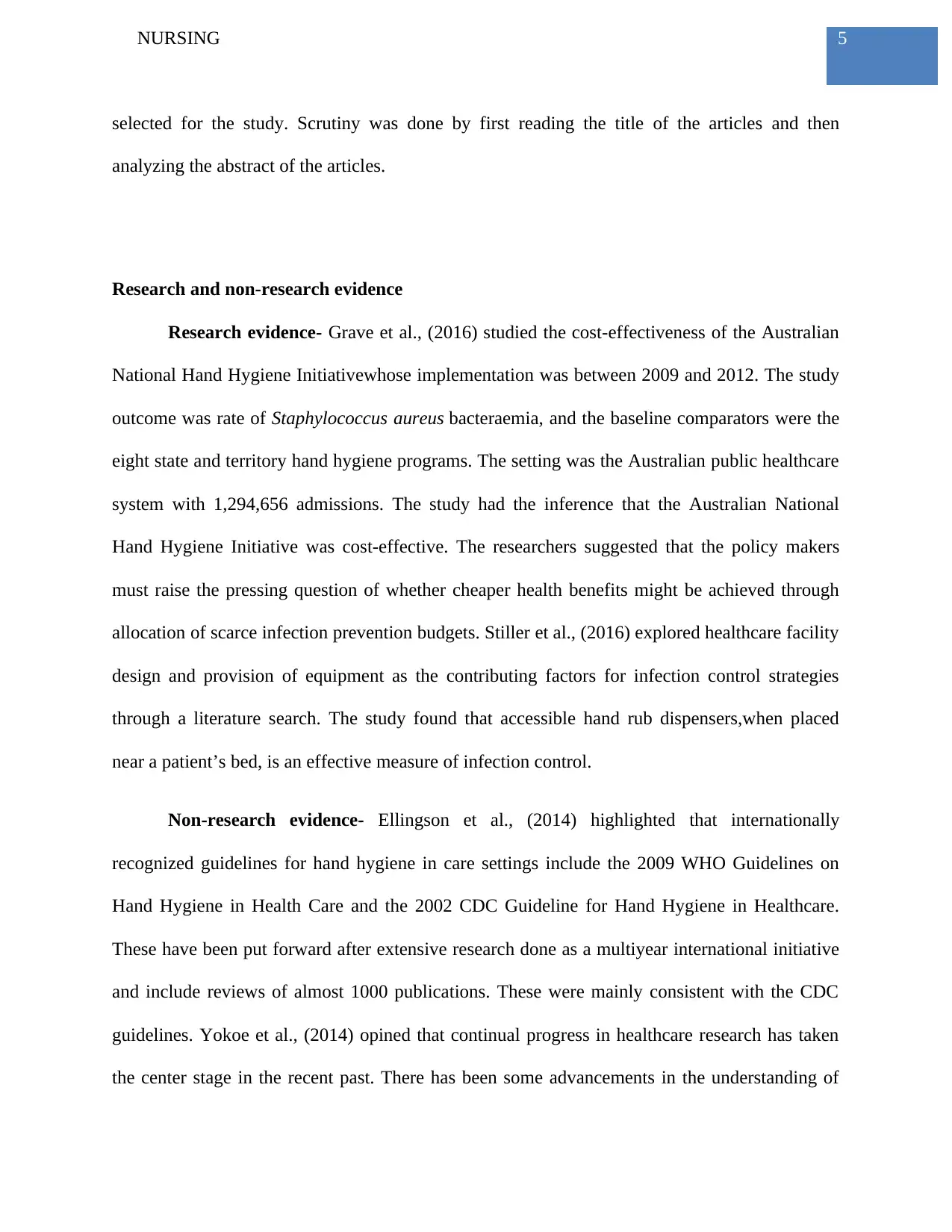
5NURSING
selected for the study. Scrutiny was done by first reading the title of the articles and then
analyzing the abstract of the articles.
Research and non-research evidence
Research evidence- Grave et al., (2016) studied the cost-effectiveness of the Australian
National Hand Hygiene Initiativewhose implementation was between 2009 and 2012. The study
outcome was rate of Staphylococcus aureus bacteraemia, and the baseline comparators were the
eight state and territory hand hygiene programs. The setting was the Australian public healthcare
system with 1,294,656 admissions. The study had the inference that the Australian National
Hand Hygiene Initiative was cost-effective. The researchers suggested that the policy makers
must raise the pressing question of whether cheaper health benefits might be achieved through
allocation of scarce infection prevention budgets. Stiller et al., (2016) explored healthcare facility
design and provision of equipment as the contributing factors for infection control strategies
through a literature search. The study found that accessible hand rub dispensers,when placed
near a patient’s bed, is an effective measure of infection control.
Non-research evidence- Ellingson et al., (2014) highlighted that internationally
recognized guidelines for hand hygiene in care settings include the 2009 WHO Guidelines on
Hand Hygiene in Health Care and the 2002 CDC Guideline for Hand Hygiene in Healthcare.
These have been put forward after extensive research done as a multiyear international initiative
and include reviews of almost 1000 publications. These were mainly consistent with the CDC
guidelines. Yokoe et al., (2014) opined that continual progress in healthcare research has taken
the center stage in the recent past. There has been some advancements in the understanding of
selected for the study. Scrutiny was done by first reading the title of the articles and then
analyzing the abstract of the articles.
Research and non-research evidence
Research evidence- Grave et al., (2016) studied the cost-effectiveness of the Australian
National Hand Hygiene Initiativewhose implementation was between 2009 and 2012. The study
outcome was rate of Staphylococcus aureus bacteraemia, and the baseline comparators were the
eight state and territory hand hygiene programs. The setting was the Australian public healthcare
system with 1,294,656 admissions. The study had the inference that the Australian National
Hand Hygiene Initiative was cost-effective. The researchers suggested that the policy makers
must raise the pressing question of whether cheaper health benefits might be achieved through
allocation of scarce infection prevention budgets. Stiller et al., (2016) explored healthcare facility
design and provision of equipment as the contributing factors for infection control strategies
through a literature search. The study found that accessible hand rub dispensers,when placed
near a patient’s bed, is an effective measure of infection control.
Non-research evidence- Ellingson et al., (2014) highlighted that internationally
recognized guidelines for hand hygiene in care settings include the 2009 WHO Guidelines on
Hand Hygiene in Health Care and the 2002 CDC Guideline for Hand Hygiene in Healthcare.
These have been put forward after extensive research done as a multiyear international initiative
and include reviews of almost 1000 publications. These were mainly consistent with the CDC
guidelines. Yokoe et al., (2014) opined that continual progress in healthcare research has taken
the center stage in the recent past. There has been some advancements in the understanding of
⊘ This is a preview!⊘
Do you want full access?
Subscribe today to unlock all pages.

Trusted by 1+ million students worldwide
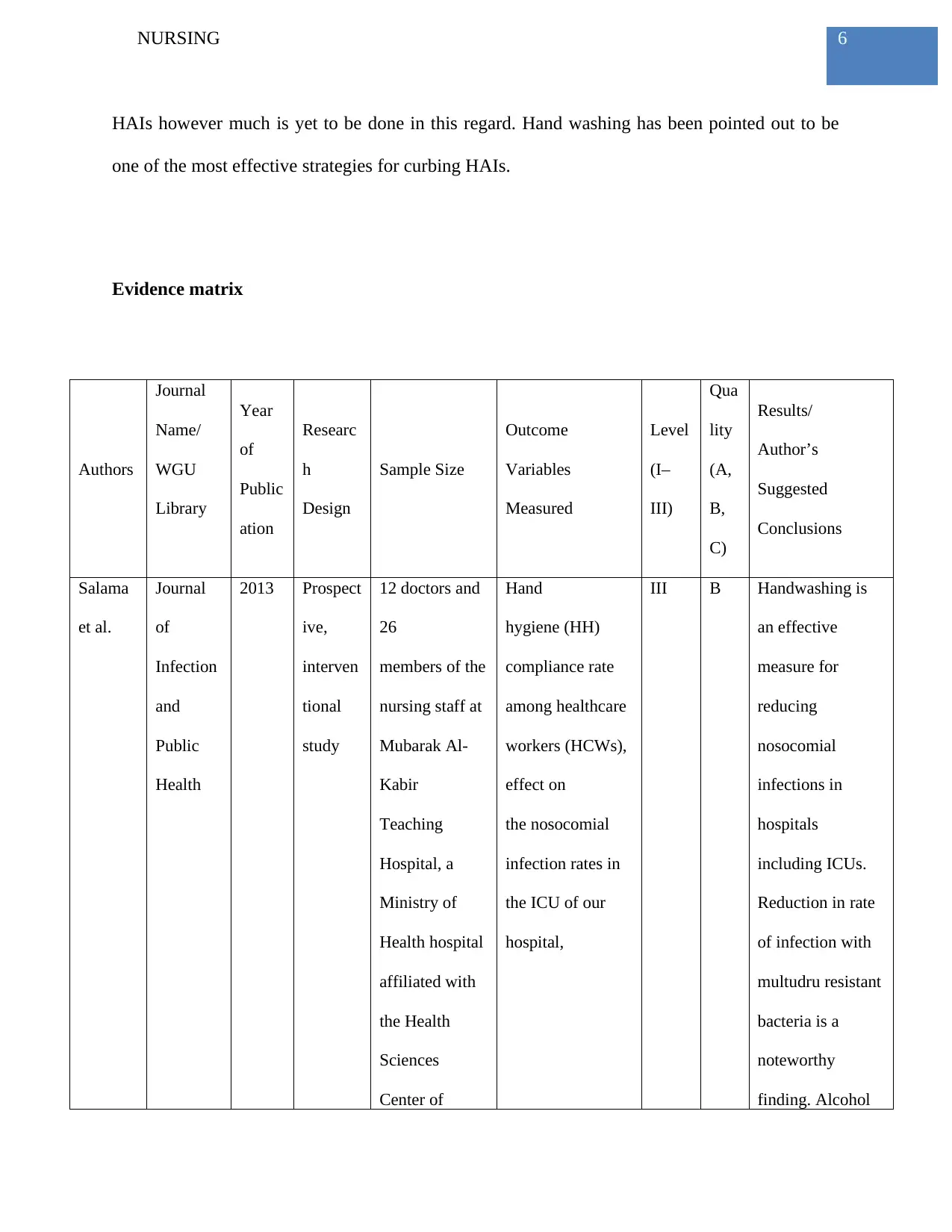
6NURSING
HAIs however much is yet to be done in this regard. Hand washing has been pointed out to be
one of the most effective strategies for curbing HAIs.
Evidence matrix
Authors
Journal
Name/
WGU
Library
Year
of
Public
ation
Researc
h
Design
Sample Size
Outcome
Variables
Measured
Level
(I–
III)
Qua
lity
(A,
B,
C)
Results/
Author’s
Suggested
Conclusions
Salama
et al.
Journal
of
Infection
and
Public
Health
2013 Prospect
ive,
interven
tional
study
12 doctors and
26
members of the
nursing staff at
Mubarak Al-
Kabir
Teaching
Hospital, a
Ministry of
Health hospital
affiliated with
the Health
Sciences
Center of
Hand
hygiene (HH)
compliance rate
among healthcare
workers (HCWs),
effect on
the nosocomial
infection rates in
the ICU of our
hospital,
III B Handwashing is
an effective
measure for
reducing
nosocomial
infections in
hospitals
including ICUs.
Reduction in rate
of infection with
multudru resistant
bacteria is a
noteworthy
finding. Alcohol
HAIs however much is yet to be done in this regard. Hand washing has been pointed out to be
one of the most effective strategies for curbing HAIs.
Evidence matrix
Authors
Journal
Name/
WGU
Library
Year
of
Public
ation
Researc
h
Design
Sample Size
Outcome
Variables
Measured
Level
(I–
III)
Qua
lity
(A,
B,
C)
Results/
Author’s
Suggested
Conclusions
Salama
et al.
Journal
of
Infection
and
Public
Health
2013 Prospect
ive,
interven
tional
study
12 doctors and
26
members of the
nursing staff at
Mubarak Al-
Kabir
Teaching
Hospital, a
Ministry of
Health hospital
affiliated with
the Health
Sciences
Center of
Hand
hygiene (HH)
compliance rate
among healthcare
workers (HCWs),
effect on
the nosocomial
infection rates in
the ICU of our
hospital,
III B Handwashing is
an effective
measure for
reducing
nosocomial
infections in
hospitals
including ICUs.
Reduction in rate
of infection with
multudru resistant
bacteria is a
noteworthy
finding. Alcohol
Paraphrase This Document
Need a fresh take? Get an instant paraphrase of this document with our AI Paraphraser
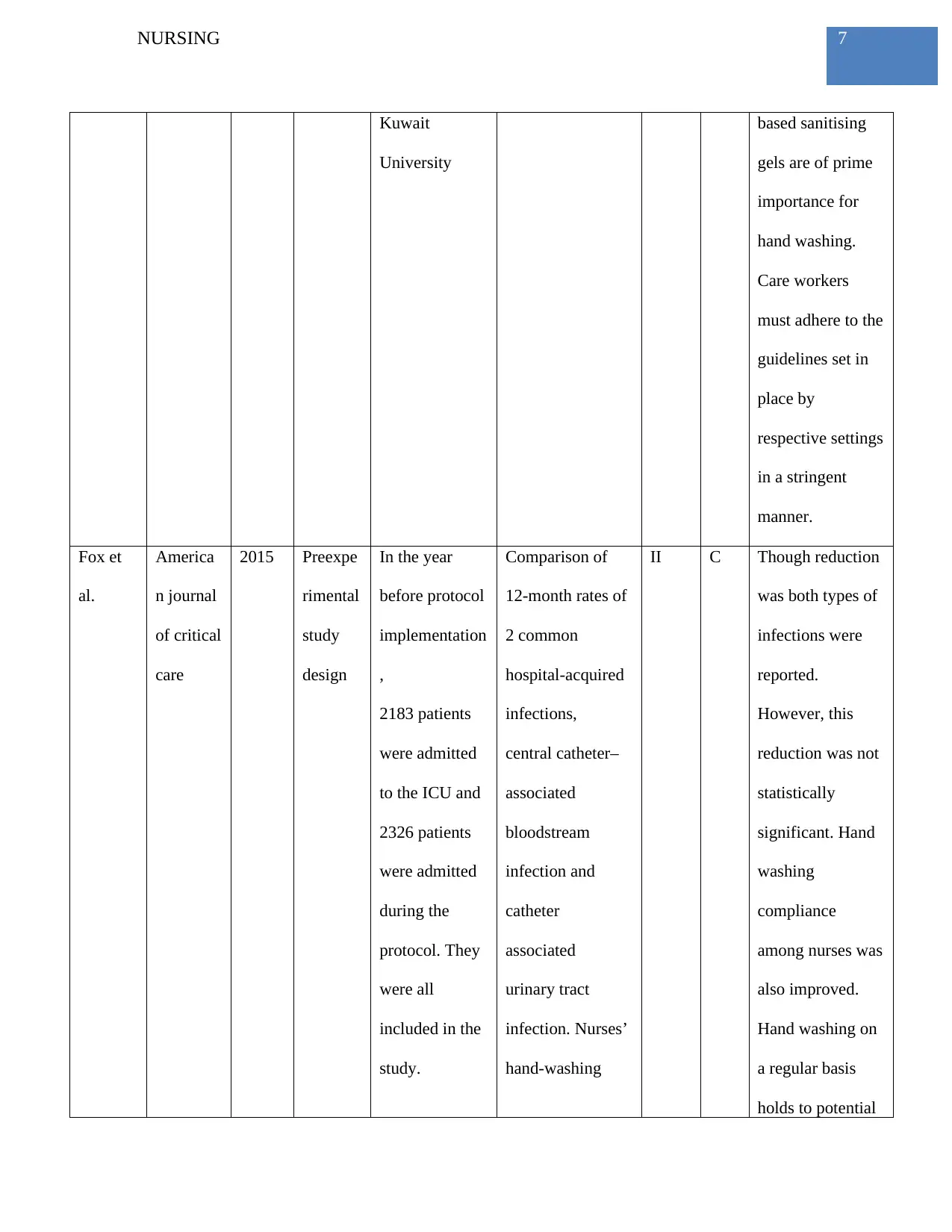
7NURSING
Kuwait
University
based sanitising
gels are of prime
importance for
hand washing.
Care workers
must adhere to the
guidelines set in
place by
respective settings
in a stringent
manner.
Fox et
al.
America
n journal
of critical
care
2015 Preexpe
rimental
study
design
In the year
before protocol
implementation
,
2183 patients
were admitted
to the ICU and
2326 patients
were admitted
during the
protocol. They
were all
included in the
study.
Comparison of
12-month rates of
2 common
hospital-acquired
infections,
central catheter–
associated
bloodstream
infection and
catheter
associated
urinary tract
infection. Nurses’
hand-washing
II C Though reduction
was both types of
infections were
reported.
However, this
reduction was not
statistically
significant. Hand
washing
compliance
among nurses was
also improved.
Hand washing on
a regular basis
holds to potential
Kuwait
University
based sanitising
gels are of prime
importance for
hand washing.
Care workers
must adhere to the
guidelines set in
place by
respective settings
in a stringent
manner.
Fox et
al.
America
n journal
of critical
care
2015 Preexpe
rimental
study
design
In the year
before protocol
implementation
,
2183 patients
were admitted
to the ICU and
2326 patients
were admitted
during the
protocol. They
were all
included in the
study.
Comparison of
12-month rates of
2 common
hospital-acquired
infections,
central catheter–
associated
bloodstream
infection and
catheter
associated
urinary tract
infection. Nurses’
hand-washing
II C Though reduction
was both types of
infections were
reported.
However, this
reduction was not
statistically
significant. Hand
washing
compliance
among nurses was
also improved.
Hand washing on
a regular basis
holds to potential
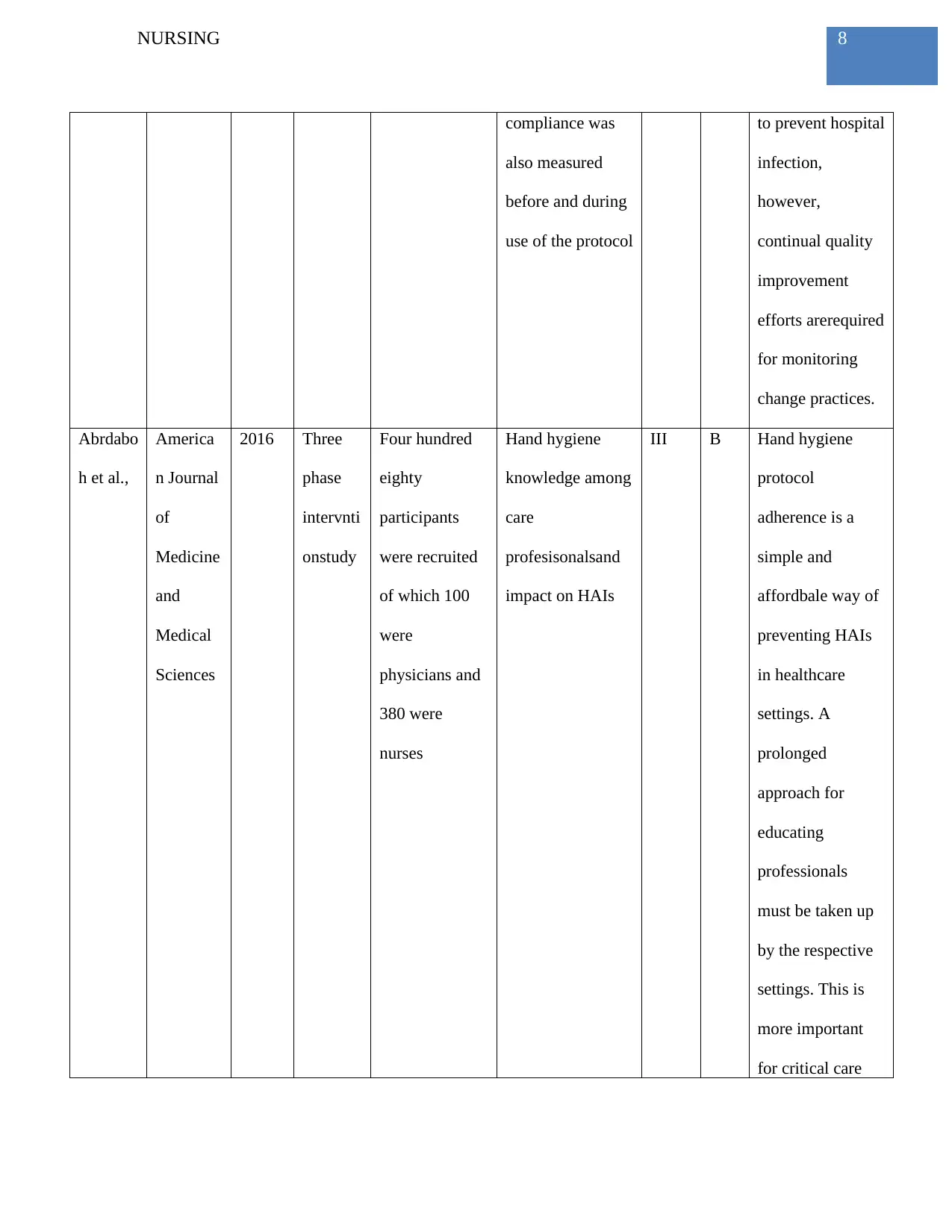
8NURSING
compliance was
also measured
before and during
use of the protocol
to prevent hospital
infection,
however,
continual quality
improvement
efforts arerequired
for monitoring
change practices.
Abrdabo
h et al.,
America
n Journal
of
Medicine
and
Medical
Sciences
2016 Three
phase
intervnti
onstudy
Four hundred
eighty
participants
were recruited
of which 100
were
physicians and
380 were
nurses
Hand hygiene
knowledge among
care
profesisonalsand
impact on HAIs
III B Hand hygiene
protocol
adherence is a
simple and
affordbale way of
preventing HAIs
in healthcare
settings. A
prolonged
approach for
educating
professionals
must be taken up
by the respective
settings. This is
more important
for critical care
compliance was
also measured
before and during
use of the protocol
to prevent hospital
infection,
however,
continual quality
improvement
efforts arerequired
for monitoring
change practices.
Abrdabo
h et al.,
America
n Journal
of
Medicine
and
Medical
Sciences
2016 Three
phase
intervnti
onstudy
Four hundred
eighty
participants
were recruited
of which 100
were
physicians and
380 were
nurses
Hand hygiene
knowledge among
care
profesisonalsand
impact on HAIs
III B Hand hygiene
protocol
adherence is a
simple and
affordbale way of
preventing HAIs
in healthcare
settings. A
prolonged
approach for
educating
professionals
must be taken up
by the respective
settings. This is
more important
for critical care
⊘ This is a preview!⊘
Do you want full access?
Subscribe today to unlock all pages.

Trusted by 1+ million students worldwide
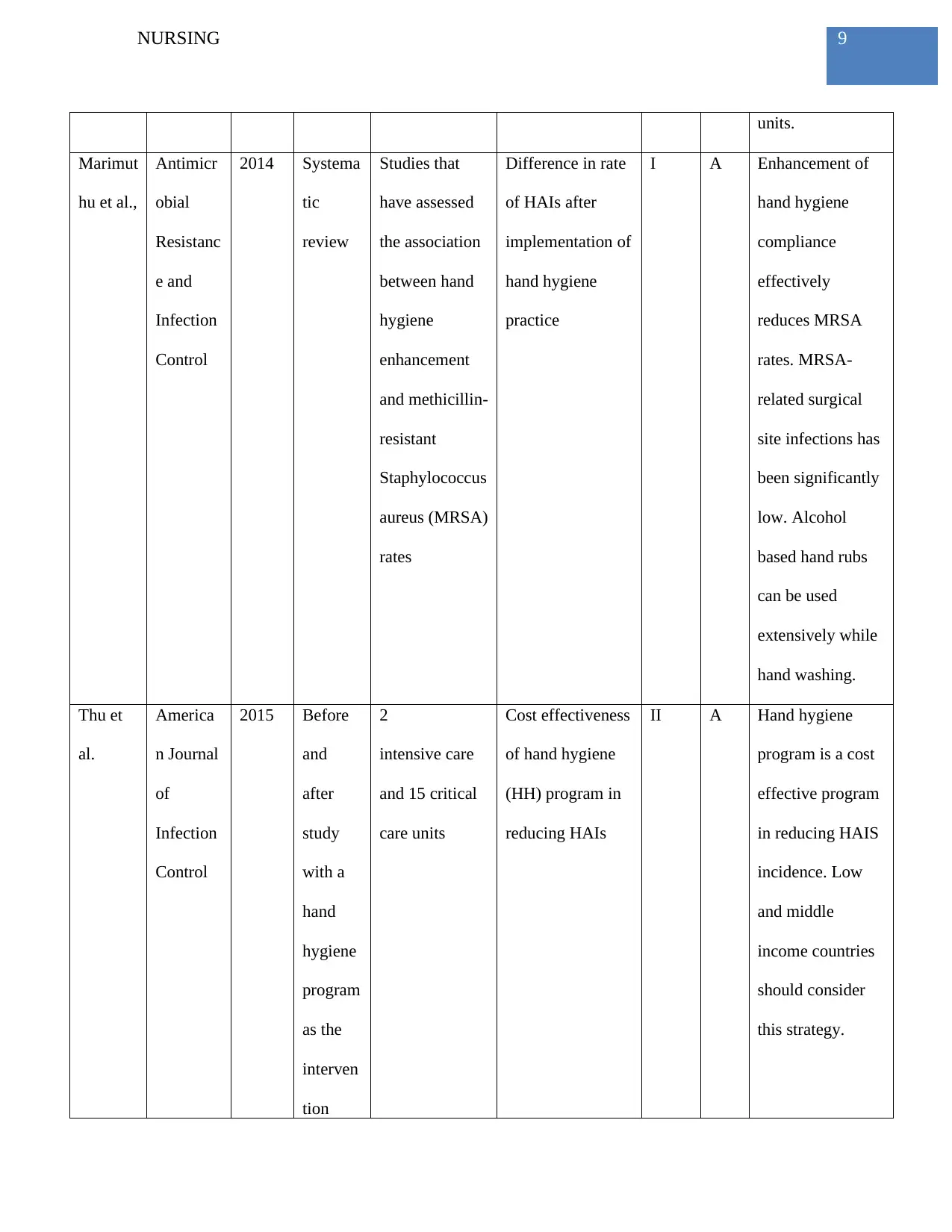
9NURSING
units.
Marimut
hu et al.,
Antimicr
obial
Resistanc
e and
Infection
Control
2014 Systema
tic
review
Studies that
have assessed
the association
between hand
hygiene
enhancement
and methicillin-
resistant
Staphylococcus
aureus (MRSA)
rates
Difference in rate
of HAIs after
implementation of
hand hygiene
practice
I A Enhancement of
hand hygiene
compliance
effectively
reduces MRSA
rates. MRSA-
related surgical
site infections has
been significantly
low. Alcohol
based hand rubs
can be used
extensively while
hand washing.
Thu et
al.
America
n Journal
of
Infection
Control
2015 Before
and
after
study
with a
hand
hygiene
program
as the
interven
tion
2
intensive care
and 15 critical
care units
Cost effectiveness
of hand hygiene
(HH) program in
reducing HAIs
II A Hand hygiene
program is a cost
effective program
in reducing HAIS
incidence. Low
and middle
income countries
should consider
this strategy.
units.
Marimut
hu et al.,
Antimicr
obial
Resistanc
e and
Infection
Control
2014 Systema
tic
review
Studies that
have assessed
the association
between hand
hygiene
enhancement
and methicillin-
resistant
Staphylococcus
aureus (MRSA)
rates
Difference in rate
of HAIs after
implementation of
hand hygiene
practice
I A Enhancement of
hand hygiene
compliance
effectively
reduces MRSA
rates. MRSA-
related surgical
site infections has
been significantly
low. Alcohol
based hand rubs
can be used
extensively while
hand washing.
Thu et
al.
America
n Journal
of
Infection
Control
2015 Before
and
after
study
with a
hand
hygiene
program
as the
interven
tion
2
intensive care
and 15 critical
care units
Cost effectiveness
of hand hygiene
(HH) program in
reducing HAIs
II A Hand hygiene
program is a cost
effective program
in reducing HAIS
incidence. Low
and middle
income countries
should consider
this strategy.
Paraphrase This Document
Need a fresh take? Get an instant paraphrase of this document with our AI Paraphraser
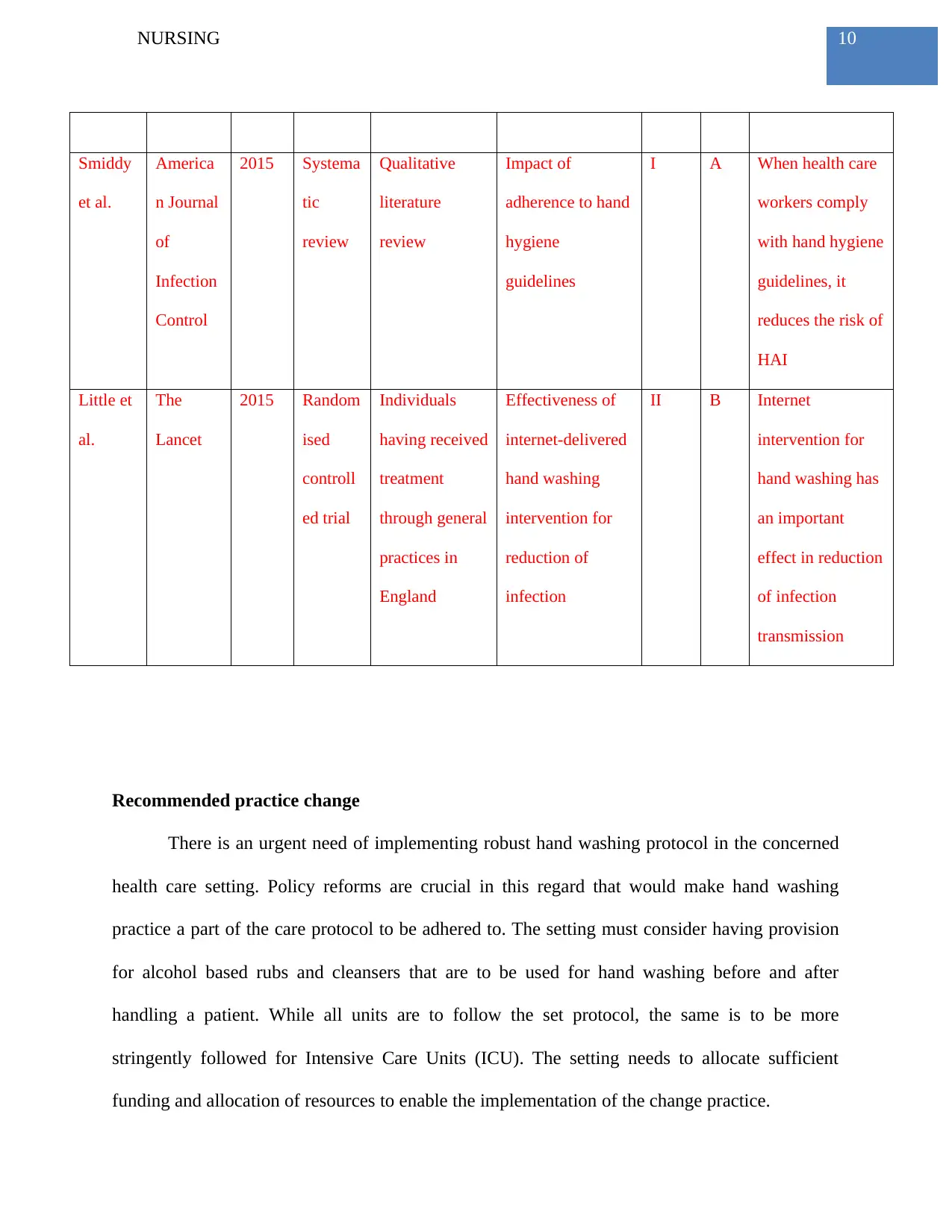
10NURSING
Smiddy
et al.
America
n Journal
of
Infection
Control
2015 Systema
tic
review
Qualitative
literature
review
Impact of
adherence to hand
hygiene
guidelines
I A When health care
workers comply
with hand hygiene
guidelines, it
reduces the risk of
HAI
Little et
al.
The
Lancet
2015 Random
ised
controll
ed trial
Individuals
having received
treatment
through general
practices in
England
Effectiveness of
internet-delivered
hand washing
intervention for
reduction of
infection
II B Internet
intervention for
hand washing has
an important
effect in reduction
of infection
transmission
Recommended practice change
There is an urgent need of implementing robust hand washing protocol in the concerned
health care setting. Policy reforms are crucial in this regard that would make hand washing
practice a part of the care protocol to be adhered to. The setting must consider having provision
for alcohol based rubs and cleansers that are to be used for hand washing before and after
handling a patient. While all units are to follow the set protocol, the same is to be more
stringently followed for Intensive Care Units (ICU). The setting needs to allocate sufficient
funding and allocation of resources to enable the implementation of the change practice.
Smiddy
et al.
America
n Journal
of
Infection
Control
2015 Systema
tic
review
Qualitative
literature
review
Impact of
adherence to hand
hygiene
guidelines
I A When health care
workers comply
with hand hygiene
guidelines, it
reduces the risk of
HAI
Little et
al.
The
Lancet
2015 Random
ised
controll
ed trial
Individuals
having received
treatment
through general
practices in
England
Effectiveness of
internet-delivered
hand washing
intervention for
reduction of
infection
II B Internet
intervention for
hand washing has
an important
effect in reduction
of infection
transmission
Recommended practice change
There is an urgent need of implementing robust hand washing protocol in the concerned
health care setting. Policy reforms are crucial in this regard that would make hand washing
practice a part of the care protocol to be adhered to. The setting must consider having provision
for alcohol based rubs and cleansers that are to be used for hand washing before and after
handling a patient. While all units are to follow the set protocol, the same is to be more
stringently followed for Intensive Care Units (ICU). The setting needs to allocate sufficient
funding and allocation of resources to enable the implementation of the change practice.
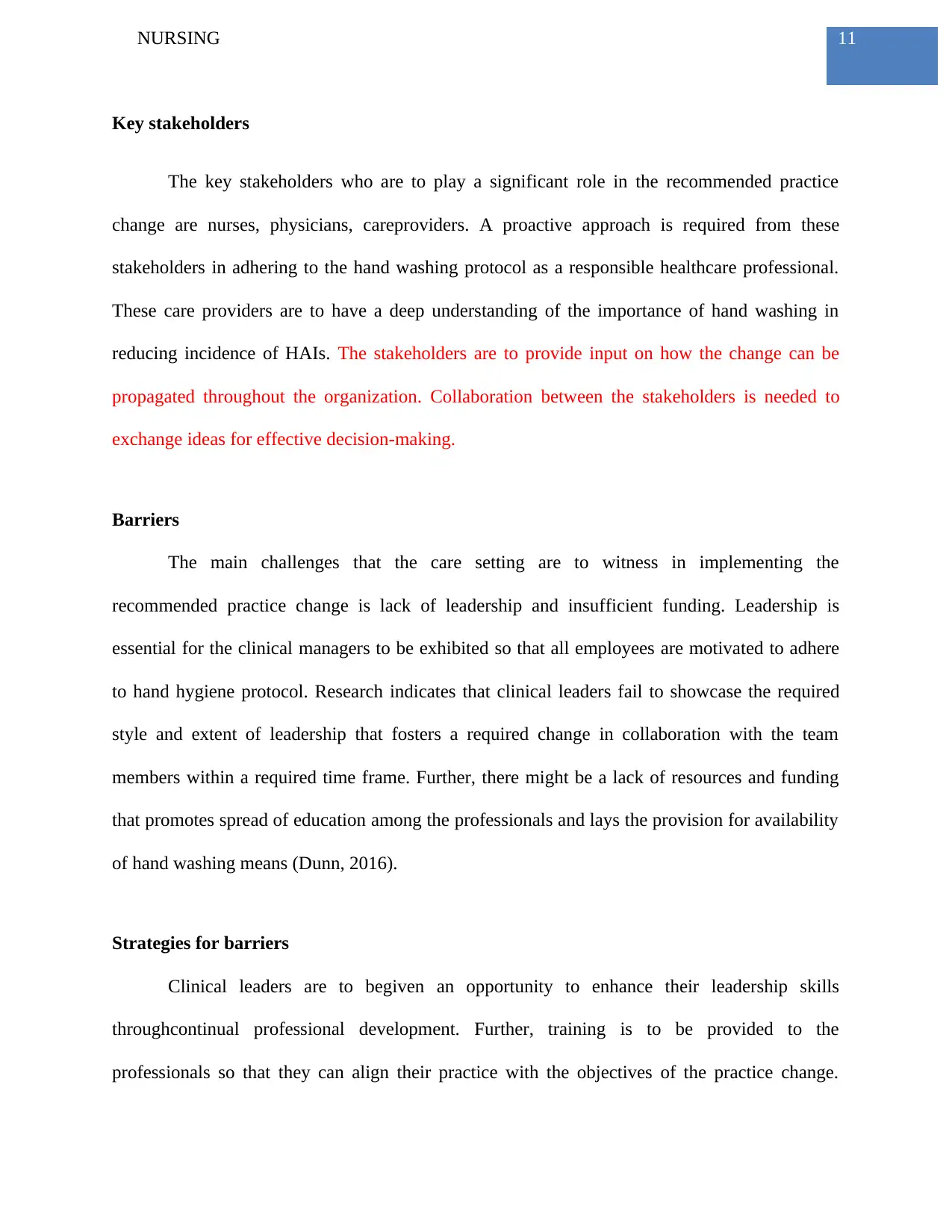
11NURSING
Key stakeholders
The key stakeholders who are to play a significant role in the recommended practice
change are nurses, physicians, careproviders. A proactive approach is required from these
stakeholders in adhering to the hand washing protocol as a responsible healthcare professional.
These care providers are to have a deep understanding of the importance of hand washing in
reducing incidence of HAIs. The stakeholders are to provide input on how the change can be
propagated throughout the organization. Collaboration between the stakeholders is needed to
exchange ideas for effective decision-making.
Barriers
The main challenges that the care setting are to witness in implementing the
recommended practice change is lack of leadership and insufficient funding. Leadership is
essential for the clinical managers to be exhibited so that all employees are motivated to adhere
to hand hygiene protocol. Research indicates that clinical leaders fail to showcase the required
style and extent of leadership that fosters a required change in collaboration with the team
members within a required time frame. Further, there might be a lack of resources and funding
that promotes spread of education among the professionals and lays the provision for availability
of hand washing means (Dunn, 2016).
Strategies for barriers
Clinical leaders are to begiven an opportunity to enhance their leadership skills
throughcontinual professional development. Further, training is to be provided to the
professionals so that they can align their practice with the objectives of the practice change.
Key stakeholders
The key stakeholders who are to play a significant role in the recommended practice
change are nurses, physicians, careproviders. A proactive approach is required from these
stakeholders in adhering to the hand washing protocol as a responsible healthcare professional.
These care providers are to have a deep understanding of the importance of hand washing in
reducing incidence of HAIs. The stakeholders are to provide input on how the change can be
propagated throughout the organization. Collaboration between the stakeholders is needed to
exchange ideas for effective decision-making.
Barriers
The main challenges that the care setting are to witness in implementing the
recommended practice change is lack of leadership and insufficient funding. Leadership is
essential for the clinical managers to be exhibited so that all employees are motivated to adhere
to hand hygiene protocol. Research indicates that clinical leaders fail to showcase the required
style and extent of leadership that fosters a required change in collaboration with the team
members within a required time frame. Further, there might be a lack of resources and funding
that promotes spread of education among the professionals and lays the provision for availability
of hand washing means (Dunn, 2016).
Strategies for barriers
Clinical leaders are to begiven an opportunity to enhance their leadership skills
throughcontinual professional development. Further, training is to be provided to the
professionals so that they can align their practice with the objectives of the practice change.
⊘ This is a preview!⊘
Do you want full access?
Subscribe today to unlock all pages.

Trusted by 1+ million students worldwide
1 out of 16
Related Documents
Your All-in-One AI-Powered Toolkit for Academic Success.
+13062052269
info@desklib.com
Available 24*7 on WhatsApp / Email
![[object Object]](/_next/static/media/star-bottom.7253800d.svg)
Unlock your academic potential
Copyright © 2020–2025 A2Z Services. All Rights Reserved. Developed and managed by ZUCOL.





